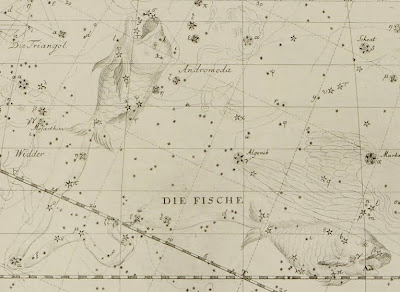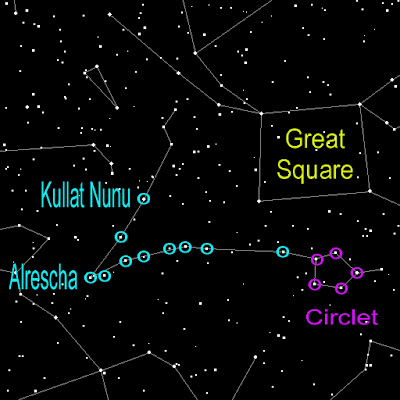The other fish in the Pisces (PIE-seez) pair is the Northern Fish, the fish that points northward. Starting at the Circlet, let’s see if we can reel in the other fish on our line.
 The Northern Fish (left) and the Western Fish (right) of Pisces
The Northern Fish (left) and the Western Fish (right) of PiscesCourtesy of Linda Hall Library of Science, Engineering and Technology
1) About an hour after your local sunset time, face south. If you don’t know the cardinal directions at your location and you don’t have a compass, make note of where the sun sets on the horizon. That spot is approximately west. Stand with your right shoulder to the west, and you’ll be facing approximately south.

Looking south to Pisces
3) Heading east from the Circlet is a streamer of eight naked-eye stars. This is the string binding the Western Fish. The terminal star--and the brightest in the string-- is called Alrescha. Alrescha (ahl-RESH-uh) is Arabic for the cord. It is also known as the Knot Star, because it marks the knot that binds the two strings--and the two fishes--together.
Alrescha is a binary star, that is, a system of two stars in orbit around each other. In Alrescha’s case, both are white dwarf stars. Because of their close proximity from our vantage point, we see their combined light as one star.
4) Heading northwest from Alrescha is the binding cord for the Northern Fish. From Alrescha, look for two bright stars spaced an equal distance apart. The second one, and the brighter of the two, is Kullat Nunu. It’s a little brighter than Alrescha. Kullat Nunu is Babylonian for cord of the fish. It’s a yellow giant and the brightest star in Pisces.
Beyond Kullat Nunu, the Northern Fish disintegrates into a jumble of not very bright stars with no readily apparent pattern to pick out. Suffice it to say that the ancients imagined a second succulent fish tethered there, ready for the fire.
Pass the tartar sauce, please.

Astronomy Essential: There are stars in the daytime sky.
If you could turn off the Sun during daylight hours--like you would turn off a light bulb--you would see a star-filled sky appear.
As the Earth spins, we are always looking out at the Milky Way and its legions of stars. During the day, those stars form a backdrop to the Sun. Consequently, they are--for the most part--not visible due to the Sun’s glaring brightness.
Ambitious amateur astronomers challenge themselves by trying to spot the brighter stars during the day, using a telescope as well as precise coordinates so they know where to point it. Popular daytime targets include: Castor and Pollux, the Gemini Twins; Rigel and Betelgeuse, brightest stars in Orion; Sirius, brightest star in our sky (after the Sun); and even not-so-bright Polaris, the North Star.